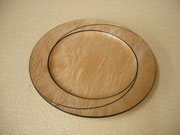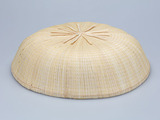Aomori and more
- Sort by
- Popularity
- Name
-
Hagi ware Hagi yaki
- Ceramic
- Yamaguchi

Hagi ware (called Hagi yaki in Japanese) is a form of porcelain produced mainly in the city of Hagi in Yamaguchi prefecture. Hagi ware is rarely decorated, remaining as simple as possible to make the most of the features of the clay. This simplici…
View more
-
Tsugaru lacquerware Tsugaru nuri
- Lacquerware
- Aomori

Tsugaru lacquerware (called tsugaru nuri in Japanese) is produced around the city of Hirosaki in Aomori prefecture. Lacquerware has been produced in this region since the middle of the Edo period (1603-1868), but it began to be called Tsugaru lacq…
View more
-
Aizu lacquerware Aizu nuri
- Lacquerware
- Fukushima

Aizu lacquerware (called Aizu nuri in Japanese) is lacquerware made in the Aizu region of Fukushima prefecture. During the manufacturing process, the craft is classified into round pieces, such as bowls, and flat pieces such as trays or stationery…
View more
-
Takaoka copperware Takaoka doki
- Metal works
- Toyama

Takaoka copperware (called Takaoka doki in Japanese) is a type of copperware produced in the area around the city of Takaoka in Toyama prefecture. The various products range from small items such as indoor ornaments, Buddhist tools, and vases to l…
View more
-
Inami wood carvings Inami chokoku
- Wood, bamboo crafts
- Toyama

Inami woodcarvings (called Inami chokoku in Japanese) are produced in the city of Nanto, Toyama prefecture mainly in the form of transoms*, decorative objects, and single-leaf screens**. They are usually made of Japanese camphor, paulownia, or zel…
View more
-
Obori-soma ware Obori soma yaki
- Ceramic
- Fukushima

Obori-soma ware (called Obori-soma yaki in Japanese) is a form of porcelain produced around the town of Namie in Fukushima prefecture. This craft uses blue porcelain enamel which is made from locally collected grindstone. The distinctive feature …
View more
-
Aizu-hongo ware Aizu hongo yaki
- Ceramic
- Fukushima

Aizu-hongo ware (called Aizu-hongo yaki in Japanese) is a traditional handicraft from the region of Aizu in Fukushima prefecture with a history of about four hundred years. This pottery, which is thought to have originated during the Sengoku perio…
View more
-
Akama inkstone Akama suzuri
- Writing tools
- Yamaguchi

Akama inkstone (called Akama suzuri in Japanese) is produced around the cities of Shimonoseki and Ube in Yamaguchi prefecture. A type of stone called akama, an ideal material for producing the inkstones, is used for Akama inkstone. Therefore this …
View more
-
Inshu traditional Japanese paper Inshu washi
- Traditional Japanese paper
- Tottori

Inshu washi is a handmade traditional Japanese paper made in the former Inaba province, the eastern part of Tottori prefecture. The most famous type of paper is a textured drawing paper that is ideal for calligraphy and ink painting, boasting high…
View more
-
Takaoka lacquerware Takaoka shikki
- Lacquerware
- Toyama

Takaoka lacquerware (called Takaoka shikki in Japanese) is produced in the area around the city of Takaoka, in Toyama prefecture. A defining feature of this lacquerware is the wide range of techniques and styles. Aogai-nuri is a technique that use…
View more
-
Ouchi lacquerware Ouchi nuri
- Lacquerware
- Yamaguchi

Ouchi lacquerware (called Ouchi nuri in Japanese) is produced around the city of Yamaguchi, in Yamaguchi prefecture. This craft emerged under the Ouchi clan, which boasted significant influence and power in the region during the Muromachi period (…
View more
-
Yumihama traditional resist-dyed textiles Yumihama gasuri
- Woven textiles
- Tottori

Yumihama traditional resist-dyed textiles (called Yumihama gasuri in Japanese) is produced near the city of Sakaiminato, Tottori prefecture. The name comes from Yumigahama, which is a curved shore that stretches for more than twenty kilometers (ab…
View more
-
Echu traditional Japanese paper Echu washi
- Traditional Japanese paper
- Toyama

Etchu washi is traditional Japanese paper made in Asahi, Yatsuo, and Taira in Toyama prefecture. Each production area makes their own type of washi which are called Gokayama washi, Yatsuo washi, and Birudan washi. This craft has slight regional va…
View more
-
Okuaizu Basketry Oku aizu amikumi zaiku
- Wood, bamboo crafts
- Fukushima

Okuaizu Basketry, called Okuaizu Amikumi Zaiku in Japanese, is basketry produced around Mishima Town, Onuma County, Fukushima Prefecture. As this mountainous area in the Okuaizu region has much snow and farmers are unable to work in the fields in …
View more
-
Shogawa woodcraft Shogawa hikimono kiji
- Industrial art materials and tools
- Toyama

Shogawa woodcrafts are mostly woodcraft articles such as bowls or trays made in a wide area of the Toyama Prefecture including the city of Takaoka and the city of Tonami. Shogawa woodcrafts were designated as a traditional craft by the Ministry of…
View more
-
Etchu Fukuoka Sedge Hats Etchu Fukuoka no suge gasa
- Other crafts
- Toyama

Etchu Fukuoka no suge gasa, Etchu Fukuoka Sedge Hats, are a traditional craft produced in Takaoka, Tonami, Oyabe, and Nanto of Toyama prefecture. The sedges produced in Fukuoka, Toyama are top quality as they survive the severe winters of the Hok…
View more
-
Oku-Aizu Showa Karamushi Textiles Okuaizu showa karamushi ori
- Woven textiles
- Fukushima

Oku-Aizu Showa Karamushi Textiles (Oku-Aizu Karamushi Ori in Japanese) are a textile fabric produced in Showa Village of Ohnuma, Fukushima Prefecture. It is made from ramie, which is an urticaceous plant also known as China grass. Fine hemp cloth …
View more
- 1































































































































































































































































































